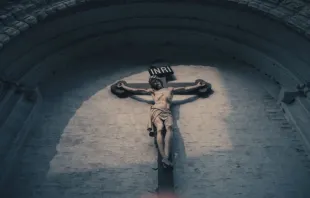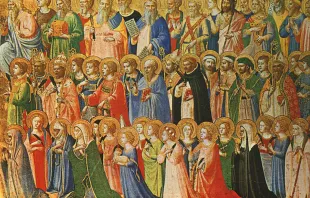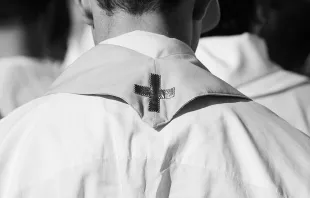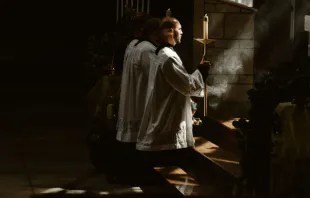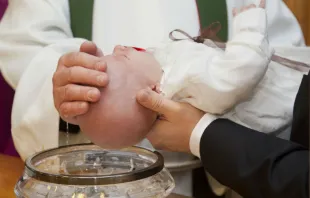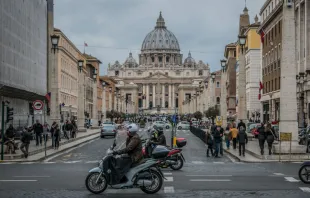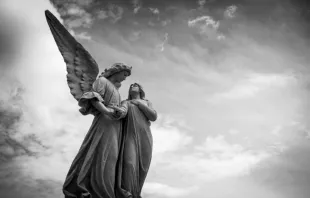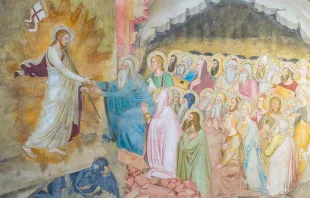Articles by Msgr. M. Francis Mannion
The practice of Lenten fasting has many dimensions
Apr 12, 2019 / 00:00 amFasting is one of the practices associated traditionally with the season of Lent—a practice which has a rich body of meanings. I suggest there are seven values to be derived from fasting. The first value of fasting is learning reverence for food. We live in a consumer society where food is available in abundance and is habitually wasted. Food is viewed as purely functional; rarely do we think of food as a precious gift from God. Fasting gives us the occasion to interrupt our normal consumerist attitudes regarding food, and allows us to grow in reverence for it. The second value of fasting is that it provides us a means of assisting the hungry poor. The scriptures are full of admonitions about sharing food with others. Indeed, the extent to which we share our food is one of the criteria by which God will judge us ultimately. There are numerous ways in which we can fast for charitable purposes during Lent. We can shop more economically so that we may contribute more to charity. We can eat more sparingly and put what we save aside to assist others. The third value of fasting is in helping us grow in humility. Humility means a realistic, clear-sighted, and sober sense of ourselves and our place in the world. To be humble is to have a sense of our own limitations. We become more aware of our mortality and the fact that we must die. We realize that our lives are fragile. There are few things that make us more aware of our limitations, our mortality, and our dependence on others than being hungry. Hunger cuts us down to size and deflates our egos. The fourth value associated with fasting is that it teaches us discipline. Discipline means self-restraint and appropriate self-restriction – all marks of the mature person. Their opposites are self-indulgence, the inability to control ourselves, and the tendency to live with restraint. Fasting involves external discipline teaching us internal discipline. The practice of fasting can have the inner effect of making us more genuine and authentic disciples of Christ. The fifth value of fasting is that we undertake the practice in solidarity with the poor. This means recognizing that as long as there are poor people in the world, it is unseemly that we should eat luxuriously. We are called to live more simply, more sparingly, and to avoid waste and self-indulgence in a spirit of union with those who have little. As long as there is hunger in the world, a permanent element of fasting should characterize our hunger. The sixth value of fasting – especially on Good Friday, when all Catholics are required to fast – is to express solidarity with Jesus on the day of his death. On the day of Christ’s trial, suffering, and death, Christians are called to live in a sober way, avoiding entertainments and distracting activities. As Christ suffers on the Cross on Good Friday, Christians are called to observe that day with a firm gaze on Christ’s saving action. Finally, we fast in preparation for the return of Christ in glory. We are reminded that we can never be satisfied by ordinary food, food that satisfies only momentarily but then perishes. We do not live by bread alone. What we await is the food of heaven, the food of God’s heavenly banquet which will not perish but give life eternal. Until then, we will always be hungry.
Prosperity gospel is a travesty of the good news of Christ
Jan 20, 2019 / 00:00 amPerhaps the most appalling aspect of televangelism is what is called “the prosperity gospel,” that is the conviction that God rewards faithful Christians with money and a prosperous mode of life when they support a ministry financially. Sums of money that often stretch the finances of the faithful to breaking point are implicitly encouraged by television pastors. By donating “seed” money to the ministry, the congregant is promised a bountiful harvest. This kind of preaching and fundraising is associated with television evangelists like Kenneth Copeland, Benny Hinn, Bishop Eddie Long, and Creflo Dollar (that’s his real name!). One or other of the many “prosperity” televangelists may be seen on cable television virtually every night. The underlying theology of prosperity preaching is based on passages like Deuteronomy 18:8, which states: “Remember, then, it is the Lord, your God, who gives you the power to acquire wealth.” (Taken out of the context of the whole Bible, this quotation seems to legitimize the televangelist message.) The fact that prosperity does not in fact materialize for many givers does not seem to trouble them. On the other hand, whatever small financial good appears in their lives is interpreted as God’s gift. The most scandalous aspect of this mode of evangelism is that the preachers themselves are the recipients of large amounts of money, principally through enormous salaries. Many commentators complain about the lavish lifestyles of preachers that are funded by “seed” money given by the less prosperous. Creflo Dollar recently purchased a $67 million private jet—and his congregation approved of the move as an indication that Dollar is being blessed by God. The principle of divine blessing is used to justify the multi-million dollar salaries and benefits (including luxurious homes, lavish vacation properties, and private jets.) But they are beyond criticism by adherents, because to criticize them is to questions God’s manifold blessings. There is also the notion, derived from the Swiss reformer John Calvin (and assumed generally into Protestantism), that material and financial prosperity is a sign of God’s blessing of the righteous. By the same logic, those who are poor and struggle with poverty must be sinners and lack God’s blessing. I am fairly certain that today there is no incidence of Catholic clergy or organizations directly preaching the prosperity gospel. But a practice not dissimilar to this was present in the scandal that led in part to the Protestant Reformation. Catholic preachers of that era did not promise financial prosperity (or live lavish lifestyles), but they did declare that souls could be delivered from purgatory through financial contributions to the Church. While the sale of indulgences to support Roman expenditures was expunged from Catholicism after the Council of Trent, there is a danger that parish and diocesan stewardship programs can be tainted with the prosperity gospel and its theology. I myself have heard people give testimony at Mass intimating that their stewardship contributions have brought a substantial improvement in their personal finances. Collections at Mass and fundraising programs in parishes and dioceses need to avoid assuming the elements of the prosperity gospel. The notion that God gives back financial or material gain in response to donations made to the Church is a travesty of the Gospel of Christ, who was himself poor, and lived frugally on what was offered to him. Christians properly donate to the Church’s mission and to other good causes in order to build up a culture of charity and mercy.
Heaven is the fulfilment of earth
Jan 18, 2019 / 00:00 amRecently I received a letter from a lady in Seattle in which she said that when she dies she will miss all the good things of this life. She said that while she wants to go to heaven, she does not want to go to some sterile place. Heaven might not be as interesting as earth. What follows is an adaptation of my response to her. (She gave me permission to publish it as long as I did not use her name.) With many people you share the notion that heaven and earth are disconnected and that at the end of time the earth will be no more. But the authentic Catholic view is that God will save not only our souls, but also our bodies and, indeed, the whole created order within which human persons exist. The Constitution on the Church of Vatican II states: “The Church . . . will receive her perfection only in the glory of heaven, when will come the time of the renewal of all things. At that time, together with the human race, the universe itself, which is so closely related to man and which attains its destiny through him, will be perfectly re-established in Christ” (no. 48). The Bible speaks of this renewal of the universe as the coming about of a “new heavens and a new earth” (2 Peter 3:13). This will be the complete realization of the glorious end for which humanity and the whole created order are destined. In his letter to the Romans, St. Paul speaks of a profound unity of all things in heaven: “For the creation waits with eager longing for the revealing of the sons of God . . . in hope because the creation itself will be set free from its bondage to decay . . . We know that the whole creation has been groaning in travail together until now; and not only the creation but we ourselves, who have the first fruits of the Spirit, groan inwardly as we wait for adoption as sons, the redemption of our bodies” (8:19-23). The whole created order is, then, destined to be transformed so that the world will be restored to the original state it had in the Garden of Eden and will therefore be a place without pain, suffering, and loss. In this light, then, heaven will not at all involve the loss of the good things of earth (our families, friends, good works, and arts), but these will be found in a new way in heaven. The Constitution on the Church in the Modern World of Vatican II declares: “When we have spread on earth the fruits of our nature and our enterprise . . . according to the command of the Lord and in his Spirit, we will find them once again, cleansed this time from the stain of sin, illuminated and transfigured, when Christ presents to his Father an eternal and universal kingdom” (no. 39). Christian life, then, is not a preparation which is detached from earth. Rather it is precisely through the way we shape our lives, build up our relationships, create the human heritage, and beautify and conserve the earth – in this way we prepare for heaven. When Christ comes again in glory he will bring with him the Kingdom of heaven which will raise up and transform the earth in all its glorious, magnificent, and joyful aspects.
Thanksgiving Day invites a generous attitude of blessing
Nov 21, 2018 / 00:00 amSome time ago, I came across a book entitled, “The Book of Irish Curses.” The book was intended to be light-hearted and tongue-in-cheek – and in many ways it was. But as one read through the colorful variety of curses, one came to see something negative and destructive at work. Even if one does not believe in the magical power of curses, one can still recognize that curses intend to destroy and tear down, to sow dissension and ruin in the human environment. The opposite of cursing is blessing. In 1989, the Church produced “A Book of Blessings,” and, in 2007, a book of “Catholic Household Blessings and Prayers.” As one reads through their contents, one senses their creative, edifying, and ennobling character. It has long been recognized that the ability to give thanks is the mark of the truly religious person. Without the sense of thanksgiving, we fail to have openness to God, to others, to our own personal histories, and to the goodness of life itself. That is why blessing and cursing are more than a matter of words. Both invoke whole attitudes toward life. It does not take much reflection to realize that there is a close relationship between the way we think, the way we speak, and the way we act. Many people curse themselves without even knowing it when they think, speak about, and evaluate their own lives in negative and pessimistic terms. To say that our personal history has been disastrous and meaningless is to curse it. Whenever we say that the present is pointless and valueless, we have effectively cursed ourselves. Whenever we are hopeless and cynical about the future, we are cursing it in advance – hence already destroying it. The attitude of blessing and of thanksgiving represents quite a different stance toward life. To have an attitude of blessing is to be able to look at our past and to recognize it as good and fruitful – despite the difficulties and failures. It is to be able to look to the present and, without overlooking the shadow side, to recognize it as worthwhile and creative. To bless is to be able to look to the future and, despite our worries about it, to have an attitude of hope and expectancy. In the authentic attitudes of blessing and thanksgiving, there is not for a moment any hint of escapism. To bless and give thanks is never a matter of denying the negative sides of life. Far from it: thanksgiving and blessing have great depth to them precisely to the extent that they are often made in the midst of pain and adversity. Catholics attending Mass on Thanksgiving Day cannot forget that it is precisely to give thanks and to bless that we gather. The very word “eucharist” means literally “thanksgiving.” Nor can we fail to recognize that we give joyful thanks in terms of the Lord’s suffering, death, and resurrection. Thus, on Thanksgiving Day we are invited to avoid an escapist attitude toward the darker side of life, but to have what Lutheran scripture scholar Walter Brueggemann calls “paschal joy” – a joy forged in the crucible of suffering. To be a people of blessing and thanksgiving – in attitude, word, and, deed – is one description of being a Christian – indeed, of being a religious person of any persuasion. And it is this attitude that we invoke and celebrate on Thanksgiving Day.
Was Saint Paul a male chauvinist?
Nov 3, 2018 / 00:00 amThe reading from Paul to the Ephesians (5: 21-32) on the relationship between husbands and wives read at Sunday Mass recently probably causes more argument and irritation than any other text in the lectionary. I would argue, however, that the problem people have with this passage is a false one, for the reason that it is not actually saying what it appears to say at first hearing. In fact, its real message is almost the opposite to what we imagine it to be. In the passage, Paul says: “Wives should be subordinate to their husbands as to the Lord." He continues: "As the church is subordinate to Christ, so wives should be subordinate to their husbands in everything." The problem is that we often hear only the first part of Paul's advice: “Wives should be subordinate to their husbands." We tend to interpret this admonition to mean that wives should do what they are told, that they should be subservient and childlike. So we hear the passage as an excuse for husbands to be bossy and generally rule the roost. But this sort of thing is not at all what Paul intends. The word "subordinate” has to be interpreted in authentically Christological terms. What does it mean to say that the church is “subordinate” to Christ? It means that the church is open to all the love, grace, and mercy offered in Christ, and is willing to cooperate with Christ for the salvation of the world. So, the admonition that wives should "be subordinate to their husbands" means that wives should cooperate with their husbands in all those things that are important for the good of the marriage and the family, as well as for the good of the wife herself. Be of one heart and mind with your husband, Paul is saying. Truly listen to your husband, allow him to do the good of which he is capable. Be open to all that is Christ-like in him. Paul goes on to say in this passage, “Husbands, love your wives even as Christ loved the church.” Of course, we are inclined to think that the admonition, "Husbands love your wives" is weaker than "wives should be subordinate to their husbands." This is not the case. No less is demanded by Paul of husbands than of wives. Paul tells husbands to “love your wives even as Christ loved the church.” This is strong language. Christ’s love for his church is undying, eternal and without limit. It is truly sanctifying, and full of grace, forgiveness, and compassion. There is no element of oppression or degradation whatsoever in Christ's relationship to the church. We can, of course, still object to one more phrase in Paul's advice: “The husband is head of the wife.” This assertion can seem oppressive and demeaning in our modern cultural context. But, again, listen to the total statement, which is, "the husband is head of his wife just as Christ is head of the church." So we have to ask: What is the practical meaning of Christ's headship of the church? It is that he serves his church with complete devotion, love, and self-sacrifice. Christ died for his church Christ's headship of the church subverts, revolutionizes, and replaces every cultural notion of headship. Christ is head of the church not as overlord, führer, tyrant, dictator, top dog. He is head of the church as servant. This point is made over and over again in the New Testament, and it cannot be emphasized enough here. Paul is calling husbands to undying service of their wives and children in the model of Christ. All in all, then, in this passage from Ephesians, Paul is presenting a most noble dignified, and loving vision of Christian marriage. Paul places Christian marriage on the highest spiritual plane and he sets out an elevated view of how husbands and wives should love each other.
All Saints’ Day includes every man and women of goodwill
Oct 31, 2018 / 00:00 amThe month of November opens with the celebration of one of the richest feasts of the liturgical year, the Solemnity of All Saints. On this day, the Church celebrates the festival of God’s holy city and the redeemed citizenry of heaven. The feast of All Saints celebrates all those who lived in the model of Christ and inspired their fellow men and women in a remarkable way. The saints made a great difference in the world, and even now they continue to inspire us to do great things. The saints are not simply nice decorations in the world of Christian spirituality. A struggling humanity needs their example and inspiration desperately. Gerald Vann, a 20th century English spiritual writer, puts this well when he writes: “For the church is, and has always been, a net that has caught all sorts of fish. She is, and has always been, a strange combination of the drab and the magnificent, the squalid and the heroic, the shabby and the beautiful. Her garden has produced both weeds and flowers. The saints are the flowers, and we must admit that without them the sanctity of the Church would not be very much in evidence. It is through them that Christ’s light shines to the nations, and it is in them that Christians see what holiness really means. It is no wonder then that the Church takes pride in those noble examples of Christian living, and boldly proclaims their greatness to the world.” The saintly men and women do not exist in a world beyond or disconnected from ours, but are part of the very fabric of our existence. The modern person likes to think that he or she is self-made. But the fact is, we are what we are because of those who have gone before us. We are brought to birth by others. We are formed by the spiritual inheritance of other generations. We live our lives happily only in community and our lives are profitable only when directed to the up – building of the human community. We are saved and brought to final fulfillment not by anything we ourselves are able to do – but by the God of mercy and redemption, and through the assistance of countless others in the spiritual community of God’s people. The saints exist for us and with us. We venerate them not as distant historical figures but as brothers and sisters with whom we are joined in a living communion. The great French writer Paul Claudel pointed out that the treasures of all the saints are at our disposal. “All the saints and the angels belong to us. We can use the intelligence of St. Thomas, the right arm of St. Michael, the hearts of Joan of Arc and Catherine of Siena, and all the hidden resources which have only to be touched to be set in action. . . . The heroism of the missionary, the inspiration of the Doctors of the Church, the generosity of the martyrs, the genius of the artists, the burning prayer of the Poor Clares and Carmelites – it is as if all that were ourselves; it is ourselves.” Like all great feasts of the liturgical year, the Solemnity of All Saints is a celebration of the Church living in history now. The stories of the saints are our stories, and our own little stories are ennobled and exalted by becoming part of the great Christian story. In this truth we should find great hope and encouragement.
A new model of catechumenal formation needs promotion
Oct 28, 2018 / 00:00 amThe Rite of Christian Initiation of Adults (RCIA) is one of the most successful features of post-Vatican II liturgical renewal. It replaced the old inquiry class model, in which the priest (generally a priest) taught the inquirer (or inquirers) about doctrine and morals. The place of formation was the classroom, the symbol was the blackboard, and the leader was like a lecturer. This model continues in some parishes today. With the near demise of the inquiry class model after Vatican II, there emerged a second (and current) model which focuses on personal religious experience in a group setting. The model is akin to the therapy group (like that of Alcoholics Anonymous). The place of formation is like a living room, the leader is a therapist, and the symbol is the mirror – in which one sees only oneself. In this newer approach, it is commonplace to hear an emphasis on personal experience over doctrine. Doctrinal formation is secondary to personal story-telling and group reflection. Without wishing to return to the old inquiry class format, or keeping the current experience-based model, there is, perhaps, a third way of viewing and practicing RCIA formation which would avoid the problems of the first and second models, yet incorporate the strengths of both. In 1984, the Yale University Lutheran theologian George Lindbeck wrote a landmark book entitled, The Nature of Doctrine. While Lindbeck was not concerned with the RCIA, his theological insights are helpful in envisaging a more adequate model of RCIA formation. Lindbeck begins by showing how Christian doctrine can easily be locked into a rigid and excessively abstract mold, and it has great difficulty connecting with people’s experience. This style of theology is what is found in the first model of the RCIA. Lindbeck points out, however, that the newer style of theology (found in model two of the RCIA) that has emerged in recent decades is no less problematic because it tends to view truth as dwelling in individual hearts and minds, and to regard doctrine at best as a guide to the clarification of inner religious experience. This kind of theology is overly subjective and generally anti-intellectual. Lindbeck proposes a style of theology that is neither strictly doctrinal nor strictly experiential. He calls it “cultural linguistic.” What this implies at its simplest is that RCIA formation should focus on the history, symbols, art, language, culture, practices, devotions, spirituality – and most all the liturgy – of the Church. As an example of this approach, I would identify Bishop Robert Barron’s landmark series, Catholicism. RCIA formation in this model would help initiate catechumens into the rich and wonderful world of Catholic life. It would teach them how to learn the culture and speak the language of Catholicism. In this kind of formation, the locale of formation might be the church building, the leader would be the holy man or woman, and the symbol would be the icon in which one encounters Christ. If the old inquiry class is out of fashion today and the experience-based model is becoming increasingly so, it is not because doctrine, on the one hand, and experience, on the other, are unimportant, but because they are set in opposition to each other. In the third mode, doctrine and experience, knowledge and spirituality, the rational and the intuitive are integrated. Doctrine and experience clarify each other. What we need today is a form of RCIA formation that incorporates the strengths of solid doctrinal formation with the spiritual vitality that is such an important feature of Catholic life.
Lay ministry and ordained ministry complement each other
Jun 21, 2018 / 00:00 amRecently, a young man considering the priesthood told me that he thought the rise of lay ministry in the Church was threatening the role of the ordained priest. What our conversation brought home to me was the ongoing confusion regarding the specific identity of and relationship between lay and ordained ministries. There are many factors that prevent clarity in this area. Chief among them is a failure to observe that while ordained ministry is general and comprehensive, lay ministry is always specific and limited. The ministry of the bishop, for instance, is not focused on any particular area of the life of his diocese. Rather it ranges widely over the whole spectrum of diocesan activities. In the same way, the parish priest is called to carry on a comprehensive and wide-ranging ministry of oversight in his parish. His focus is not on any particular ministry area, but on the right ordering (think “holy orders”) of the parish. The role of the lay person, on the other hand, is more specific – even if the same person carries on a number of ministerial activities at the same time. In the liturgy, the lay person is a reader, or an extraordinary ministry of Communion, or a musician. In the parish at large, men and women may be participants in one of the many ministries that build up the parish community: a catechist, a servant of charity, a visitor to the sick. For this reason, a generalized lay ministry should be regarded as extraordinary. This is not to say that a lay person may not perform the more general task of coordinating and directing a group of lay ministers. A director of religious education is a good example here. Yet, even then there remains a clear focus on a definite grouping of ecclesial ministries. When, however, the function of lay coordination and direction loses it focus, it becomes blurred and begins to take on the character proper to the ordained. In this perspective, we can see that, properly defined, lay ministry is no threat to the ministry of the ordained. Indeed, the opposite is the case. Each type of ministry is directed to the other. Without the existence of ordained ministry, the ministerial role of lay persons would never come to be. By the same token, the vocation of the ordained is to generate and promote the ministries of all the baptized. Indeed, one can say that the measure of effective ordained ministry is the extent to which it brings forth and activates the gifts and particular vocations of the laity. This explanation satisfied my friend – to some extent. However, he thought that this casts the role of the ordained priest into no more that a purely functional manager or moderator of parish ministries. Accordingly, I had to expand my explanation by pointing out that the priest is more than a managerial functionary. He is, in fact, called to the vocation of “ordering” the sacramental life of the parish. This is expressed most fully in the priest’s unique role in the celebration of the Eucharist, where he acts “in the person of Christ” in an irreplaceable manner signified by priestly ordination. But, my friend asked again, do not all Christians act “in the person of Christ” in carrying out their baptismal vocations? Indeed, they do – but within the specific ministries to which they are assigned. This explanation satisfied my friend – “for the moment,” he added.
Evangelization means the renewal of Catholic institutions
May 27, 2018 / 00:00 amThe Catholic Church in the U.S. has been committed since Vatican II to a new and vigorous program of evangelization. However, discussions and writings on what this means have often suffered from inadequate clarity. The word “evangelization” itself may be part of the problem. While it clearly means proclaiming the Gospel, it is not always evident how this takes place. Perhaps the word “evangelization” is hampered by its association with evangelical Protestantism with its emphasis on Bible preaching and charismatic conversion processes. While this model of evangelization can be instructive for Catholicism, it is necessary to distinguish Protestant evangelization from Catholic evangelization. If Protestant evangelization is word-centered, Catholic evangelization is sacrament-centered. Catholic evangelization is properly guided by the affirmation of Vatican II that the Church has the character of a “sacrament,” a “sign and instrument” of God’s saving activity in the world. This calls to mind words attributed to St. Francis of Assisi: “Christians must proclaim the Gospel by every means possible – and if necessary use words.” Catholic evangelization does not work primarily through preaching, but by doing. Accordingly, Catholic evangelization means, in great part, a practical renewal of the institutions by which the Church has traditionally maintained a saving presence in society. An evangelizing parish means one ministering within a defined portion of the diocese. (The Catholic parish does not incidentally mean only the local community of Catholics; it means everyone living within the parish boundaries.) It means a parish church in which the liturgy is conducted in a truly public way and which is open to the whole community as a place of prayer and contemplation. Catholic churches are places for all people. Evangelization involves an excellent religious education program which reaches even beyond the Catholic community and serves as a forum for reflection and dialogue for the larger community. It requires an organized parish ministry serving the poor and suffering and offering comfort and assistance in times of need. Catholic evangelization involves a program of arts and humanities, keeping in mind Pope Benedict’s often-stated conviction that the two things most attractive to non-Catholics about Catholicism are sanctity and beauty. Catholic primary and secondary schools, colleges, and universities have always been outstanding media of evangelization. Through its colleges and universities, the Church’s influence has permeated the worlds of philosophy and education, the arts and humanities, medicine and science. The same is true of the institutions comprising Catholic Charities in every diocese (the name varies). Catholic Charities continues to have a magnificent record across the U.S. in ministry in the name of Christ to the poorest and most deprived. Catholic Charities and other institutions like it stand at the heart of the Church’s evangelizing ministry. Catholic hospitals have been among the most visible and effective means of evangelization. By their Christ-centered apostolate of healing, they have given Catholicism a powerful presence far beyond the Catholic community in evangelizing the world of medicine and health care. However, these institutions face today a crisis of identity. In one way or another they are in danger of becoming secularized. Church leaders need to lead them in a constructive way to a renewal of their original mission so that they will participate again fully in the Church’s mission of evangelization. The multi-faceted institutional presence of the Catholic Church in the U.S. since its foundation has been a monumental evangelical success and has rendered Catholicism the most visible, public religious denomination in the country. In a new era of evangelization we need to build upon and be guided by that history.
Recovering the notion of original sin
May 21, 2018 / 00:00 amOne of the topics that catechists preparing parents for the baptism of their child must explain is the notion of original sin, a topic that has, unfortunately, fallen by the wayside in recent decades. One of the best explanations I know comes from Cardinal John Henry Newman, writing at the latter part of the nineteenth century. Newman asserts that the notion of original sin makes perfect sense, and that we can, in fact, experience original sin in the world in which we live. First, Newman paints a picture of the condition of humanity and the world: “To consider the world in its length and breadth, its various history, the many races of man, their starts, their fortunes, their mutual alienation, their conflicts; and, then, their ways, habits, governments, forms of worship; their enterprises, their aimless courses, their random achievements and acquirements, the impotent conclusion of long-standing facts, the tokens so faint and broken of a superintending design, the blind evolution of what turn out to be great powers or truths, the progress of things, as if from unreasoning elements, not towards final causes, the greatness and littleness of man, his far-reaching aims, his short duration, the curtain hung over his futurity, the disappointments of life, the defeat of good, the success of evil, physical pain, mental anguish, the prevalence and intensity of sin, the pervading idolatries, the corruptions, the dreary hopeless irreligion.” Newman goes on, then, to connect all this to original sin: “What shall be said of this heart-piercing, reason-bewildering fact? I can only answer, that either there is no creator, or this living society of men is in a true sense discarded from his presence. . . . If there be a God, since there is a God, the human race is implicated in some terrible original calamity. It is out of joint with the purposes of its creator. This is a fact, a fact as true as the fact of its existence; and thus the doctrine of what is theologically called original sin becomes to me almost as certain as that the world exists, and as the existence of God.” A simpler way to explain original sin is to see it as akin to smog in the atmosphere. The newborn baby is born into a world in which to greater or lesser degrees the air is polluted. The baby did not create the smog, but if he or she is affected by it, and if he or she continues to be exposed to it, the result is ill health. In baptism the smog of original sin is removed and the child is anointed with perfumed oil, with Sacred Chrism, which signifies the pleasing aroma of the Holy Spirit. The early Fathers of the Church often wrote of the perfume of the Chrism as the aroma of heaven. A traditional way of viewing original sin is to see it as the sin of Adam. In baptism, the sin of Adam is exorcized by the grace of Christ. The child is born into the world of Adam and by baptism is brought into the world of Christ. The transition from the sin of Adam to the grace of Christ is not a matter of a few minutes of ritual. What the baptismal ritual symbolizes is not completed immediately, but goes on through the length and breadth of life. Original sin continues to have its effects in us through our life. Only in the kingdom of heaven will the grace of Christ finally triumph.
“Spirituality” without “religion” does not hold up
May 3, 2018 / 00:00 amOne hears on a regular basis these days that people are “spiritual but not religious” – thus giving up on “organized” religion. For many people, being spiritual has to do with inner feelings and conscience and a vague belief in God. There is no need of religion; in fact religion, with its creeds, codes of conduct, scriptures, sacraments, teaching authority, and clergy, gets in the way of a truly spiritual life. The sociologist Robert N. Bellah and some colleagues wrote a book 30 years ago that is still hailed as something of a classic. Entitled Habits of the Heart, the book examines the growing lack of commitment and the problem of individualism in American society, and the effects this is having on religion in the U.S. Bellah memorably identifies a woman called Sheila as a typical example of someone committed to spirituality without religion: “Sheila Larson is a young nurse who has received a good deal of therapy and who describes her faith as ‘Sheilaism.’ “I believe in God,” she says, but “I’m not a religious fanatic. I can’t remember the last time I went to church. My faith has carried me a long way. It’s Sheilaism. Just my own little voice.” Sheilaism typifies for Bellah a growing trend in in the U.S., and he entertains the scenario that eventually there may be over 220 (now 322) million spiritualties like Sheila’s in America – one per person! This would mean that formal religion would become as irrelevant in the U.S. as it is in secularized Europe. There are a number of serious problems with spiritualties detached from religion. First, there are no solid moral codes, except inner conscience. God is one’s own “little voice” (Sheila’s words). There is nothing that calls authoritatively for moral conversion. Second, the God of spirituality does not challenge, warn, demand, or judge. Self-judgment based on personal conscience has free rein, and the adherent has a very comfortable sense of what is right and wrong. Third, spirituality is intensely private and non-communal. There is no need to connect with others or to pay much attention to the communal wisdom of the church and the Christian (or any) tradition. God is himself/herself/itself very private, too, and talks to the believer in a rather unfocused way. Fourth, spirituality is generally pantheistic, that is that God is found in nature and its beauties; in fact, God is often identified with nature. Thus spiritual but not religious people say they can find God on top of a mountain or while skiing, rather than in worship in a church building. Fifth, the inner God, because he/she/it never speaks, offers little no explanation or sense of orientation about the great mysteries of life, especially suffering and death. Death is mostly the annihilation of life – and something that one generally avoids thinking about. Sixth, there is little sense of social justice. Acting justly and charitably is not intrinsic to irreligious spirituality; it is a matter of personal choice. Seventh, religion is often replaced by psychotherapy – useful for some – but not adequate to bringing people to formal religious faith. I am not suggesting (nor is Bellah) that spirituality is a bad thing. Hardly! Spirituality is at the core of religious belief and practice. One of the valuable developments in post-Vatican II Catholicism is the renewed emphasis on active participation (=internalization of the mystery) and in the discovery of the wide range of traditional Christianity spiritualties – which are always attached to religion. The fundamental problem is that spirituality detached from tradition, doctrine, moral teaching, and liturgical life becomes eventually vapid, empty, and ultimately disappointing.
Lectionary-based catechesis for converts is inadequate
Apr 20, 2018 / 00:00 amRecently, I received a letter from a woman in Portland, Oregon, with the question, “What do you think of lectionary-based catechesis for the Rite of Christian Initiation of Adults [RCIA]? I became a Catholic three years ago and I was amazed at how little I was taught using this approach. Surely there is a better way of preparing adults to become Catholics? What would you recommend that I might read to help deepen my knowledge of the faith?” My answer to the woman’s letter was more or less along the following lines, and I believe it may be relevant to people thinking about or reflecting back on their conversion process. (I hope it may also provoke RCIA catechists to think further about their ministry): Lectionary-based catechesis is a method of teaching the faith to children and adults that uses the Sunday Mass scripture readings as the basis for catechetical sessions. It is popular in all types of catechesis nowadays, and is widely promoted by catechetical organizations and publishers. The strength of lectionary-based catechesis is chiefly that it keeps Christian formation closely connected to the liturgy and helps Catholics and Catholics-to-be to know the scriptures and to use them in all aspects of their lives. In the RCIA, the reflective sessions which take place after the dismissal of catechumens at Sunday Mass are primarily lectionary based. The catechumens are sent forth after the homily “to reflect more deeply upon the word of God.” In these sessions, unofficially called “breaking open the word,” future Catholics are led to apply the scriptures they have just heard to their lives, and to make a personal connection between the homily (itself properly scripture based) and their own growth in the faith. However, lectionary-based catechesis is only one element in the whole process of Catholic education and formation. It has to be complemented by a more comprehensive and systematic presentation of the faith. Sunday morning lectionary-based sessions are not enough to expose catechumens to the necessary breadth and depth of faith. In many parishes, this fuller approach is achieved by having a second session during the week in which the doctrinal, sacramental, and moral components of faith are explored systematically. For this, some text other than the lectionary is necessary. The Catechism of the Catholic Church (CCC) should be introduced to catechumens and its resources drawn out in formation sessions. A more user-friendly text for the beginner is the United States Catholic Catechism for Adults (USCCA), published by the United States Conference of Catholic Bishops in 2006. This book is cross-referenced to the CCC, and catechumens are constantly referred to other works of theology and the spiritual life. The use of the CCC or the USCCA – or any kind of catechism – is discouraged today by many catechists and well-known speakers on the RCIA. They fear the return of a Baltimore Catechism approach to catechesis. While lip service is paid to the doctrinal and moral dimensions of faith in the newer catechesis, the emphasis is more often on personal reflection and the sharing of stories. Not surprisingly, new Catholics like yourself often complain that they did not learn a great deal in their catechumenal formation. New Catholics should see the RCIA as the beginning of life-long formation. They can continue their education by participating in more substantive adult sessions in their parish, by working their way systematically through either of the catechisms I have mentioned, or joining a well-run and solidly-focused scripture study group. I would also recommend Bishop Robert Barron’s outstanding video series Catholicism as an excellent resource.
Are eulogies allowed at funeral masses?
Feb 10, 2018 / 00:00 amThe touchiest aspects of funeral planning are music and eulogies. In my experience, at least half of the time one or more family members or friends want to give a eulogy after the Prayer after Communion of the Funeral Mass. The funeral planning meeting is no place to argue liturgical principles, lay down the law, and provide an outright refusal of the request for someone to give a eulogy at Mass. This creates bad feelings that can ripple through the family for years. But it can be an occasion to explain as gently as possible the principles involved, and come to a solution which can keep everyone relatively happy. One can explain the difference between a homily and a eulogy. The homily, given after the Gospel by the priest or deacon, is an interpretation of the person’s life by reference to the suffering, death, resurrection and ascension of Christ. First of all, the practice of eulogies at Catholic funerals is officially discouraged. In the General Introduction to the Order of Christian Funerals, we are told that a homily is to be given, “but there is never to be a eulogy” (no.27). By a eulogy is meant an elongated narration of the human achievements and qualities of the deceased person. Certainly, homilies have to have a personal quality and the homilist has to connect the readings to the life and death of the deceased. The primary emphasis is always, however on the readings and the symbols of the funeral rite-and most of all on the Cross and resurrection of Christ. There is certainly a place for the whole genre of presentations that fall under the heading of a eulogy, and this is outside the Funeral Mass, notably at the end of the funeral vigil. The church prescribes that before the end of the vigil, “a member or a friend of the family may speak in remembrance of the deceased” (no.80). Also when the vigil is completed, there is, in my opinion, a place for additional talks. Another obvious place for eulogies about the deceased is at the luncheon that generally follows the funeral. When I meet with families to prepare the funeral, and the question of talks by family members or friends come up, I always try to steer them toward the vigil. This often works. If they persist in saying something at the Funeral Mass, then I ask that only one person speak, that the talk be kept to five minutes or less, and that the content be reverent and appropriate (no jokes, no narration of unseemly episodes in the person’s life, etc). This is sometimes a tricky negotiation; the last thing a pastor wants to do is upset the family on the occasion of a funeral. No diocese in the U.S. that I know of has banned eulogies at the end of Funeral Masses, but I am aware that some in Ireland and Australia have. As things presently stand in the U.S., judgment seems to be left to the pastor.
Catholic-Orthodox reunion prospects
Jan 2, 2018 / 00:00 amAs is readily acknowledged on both sides, Catholics and Orthodox already have much in common - acceptance of the teaching of the first seven general councils of the Church, the sacraments including the Eucharist, and the apostolic succession of their bishops. It adds up to what Pope Francis, writing to Orthodoxy’s Ecumenical Patriarch of Constantinople, Bartholomew, recently called “a profound closeness” between the two bodies. But serious doctrinal differences remain, with papal primacy - the universal jurisdiction of the pope - generally seen as most serious. Here, Pope Francis’s vision of “synodality” - regional councils of bishops with some jurisdiction over local churches in their regions - may point to a way of resolving the difficulty. Beyond doctrine, however, there’s also the existential reality of much ugly history between East and West both before and since the definitive split in the year 1054. The hard feelings and suspicions that have festered in the millennium-plus since then won’t be overcome easily. The key to progress beyond that already achieved during the last half-century through dialogue and friendly gestures rests with the Russian Orthodox Church, with slightly over 100 million members by far the largest body among worldwide Orthodoxy’s 260 million. For that reason if no other, Roman Catholics would do well to learn more about the Russian Orthodox than most probably know now. Here a new 30-minute documentary film called “Faces Among Icons” offers an excellent introduction for parish and school groups trying to get up to speed in the wake of two notable anniversaries in the year now drawing to a close - the centenaries of the Bolshevik revolution in Russia and of the apparitions of the Blessed Virgin at Fatima, Portugal in which Mary urged prayers for Russia’s conversion. Produced by the Catholic News Service, the film features interviews with church leaders and ordinary Russians who discuss the rebirth of faith in Russia after decades of persecution - and sometimes coopting - by an officially atheist regime. (Information available from GErlandson@catholicnews.com.) Another good source of information is a new Pew Research Center study pulling together recent data on Orthodoxy gleaned from a variety of surveys and sources. In brief, it’s a story of good news and bad news. The good news is that the number of Orthodox Christians in the world has more than doubled in the past century. The bad news - for the Orthodox anyway - is that Orthodoxy’s growth lags far behind both Catholicism and Protestantism, with the latter two owing much of their expansion to rapid growth outside Europe while Orthodoxy, except for a significant presence in Ethiopia, has remained a largely European enmity. Moreover, despite Russian Orthodoxy’s deep roots in Russian history and culture, just 6% of its members say they attend church weekly, while 15% say religion is “very important” in their lives, and 18% report praying daily. (But 87% have icons in their homes.) Disappointing, too, is the finding that only 17% favor restored communion with Roman Catholicism. In sum, there’s work to do, and much of it can only be done by the Orthodox themselves. There is not a great deal Catholics can do to make that happen. Except, of course, pray a lot harder for our separated Orthodox brothers and sisters.
O come, Emmanuel: come, Lord Jesus!
Dec 19, 2017 / 00:00 amThe story that we narrate and celebrate at Christmas needs no rehearsal. We know it by heart. The story has ancient roots in the world before Christ. He who was born in Bethlehem over 2000 years ago had long been expected. The prophet Isaiah foretold a child who would break the yoke that bowed the people's spirit. As at the first Christmas, the Prince of Peace comes now to join us amidst the harsh realities of the present: a world torn apart, nations at war, and widespread political turmoil. And there is always the danger of World War III as terrorist nations and groups get hold of the worst and most powerful weapons of destruction ever conceived by human madness. As of now, there are over sixty million unborn American dead - on the feast of birth. The earth is beset by hunger, homelessness, human trafficking, terrorism, child abuse, and the suppression of women in the name of religion. In much of the world, poverty and wealth are growing further and further apart. Throughout Advent, we have sung the words, “O Come, O Come, Emmanuel, and ransom captive Israel.” Now we give thanks that Christ, Emmanuel, has come. To call Christ “Emmanuel,” God with us, means that his love and peace penetrate the world’s darkest realities. From him we learn how to cope in the midst of adversity. He shows us who we are; what is important; and how to live. He opens our barren hearts to new possibilities. Out of the darkness of Christmas comes light: light for peace and growth, courage and strength, hope and confidence. But Christmas offers us not only warm consolation: it offers us a very stern challenge. The challenge is that if God has become one with us, then God’s work is done today through you and me. If God is with us, then he is with us through our vocations in life. This is literally what the incarnation means: God taking on our flesh. Emmanuel, God with us, means giving bread to the poor and welcome to the homeless. Emmanuel, God with us, means the comfort we give to the lonely and the sorrowing. Emmanuel, God with us, means the love a neglected child feels when someone pays attention. Emmanuel, God with us, means the comfort the old feel when they are loved and cared for by their children and grandchildren. Emmanuel, God with us, means the devotion of children for parents, parents for children, and children for each other. Emmanuel, God with us, means re-arranging our lives because others depend on us. And, most of all, Emmanuel, God with us, means that the Word of God, the love of God, has taken flesh in you and me. What sense does it make to say that God is with us - that he is Emmanuel - if those we are responsible for don’t feel God’s love through us? God’s light has little power except as it shines through you and me. God’s warmth must be incarnate in our good deeds for those who need that warmth - or it has little presence at all. God’s peace flows out of your heart and mine - it does not drop from the skies. God answers our prayers not by great miracles mostly, but by the love, mercy, and charity we feel and express toward each other. Christmas is about Christ coming to us, and our coming to Christ - and most of all about our going out to each other. Most of all, Christmas promises us an imperishable inheritance from Christ who came once in Bethlehem will come again in glory.
Is belief in angels and archangels on the wane?
Nov 6, 2017 / 00:00 amIn both New Age spirituality and Christian fundamentalism, belief in angels is very high. However, in contemporary mainstream Christianity (including Catholicism), belief in angels has fallen on hard times. Many Christians no longer believe in angels and find the idea of such creatures no more than a lovely myth. Angels seem to be out of place in a rational, scientific world. But, as John Macquarrie, the distinguished Anglican theologian, has pointed out, it is strange that modern people would close their minds to the possibility of angels. In a world of space exploration, we are learning more and more about the inconceivable vastness of space and the infinite proliferation of worlds beyond our own. At the scientific level, we are more and more open to the possibility of life on other planets. Surely, modern people, then, should be open to the notion that God has created other orders of beings beyond those who live on earth. In Macquarrie’s words, “The panorama of creation must be far more breathtaking than we can guess in our corner of the cosmos, for there must be many higher orders of beings whose service is joined with ours under God.” The doctrine of angels tell us that human beings live in a universe created by God that is infinitely more wondrous than we know. In the Church’s liturgy, the Christian belief in angels finds its fullest expression. Early Christian commentators remind us that the Church’s liturgy is embraced by an invisible assembly of angels. St. John Chrysostom wrote, “The whole sanctuary and the space before the altar is filled with heavenly powers come to honor Him who is present on the altar.” Believers, he says, have been judged worthy “to join the powers of heaven in singing the praises of Him who is Lord of all.” Chrysostom continues: “The angels are present here. The angels and martyrs meet today. If you wish to see the angels and martyrs, open the eyes of faith and look upon this sight. For if the very air is filled with angels, how much more so the Church!” The Catholic funeral liturgy provides two beautiful antiphons referring to the angels. The first reads: “May the angels lead you into paradise; may the martyrs come to welcome you and take you to the holy city, the new and eternal Jerusalem.” The second proclaims: “May choirs of angels welcome you and lead you to the bosom of Abraham; and where Lazarus is poor no longer, may you find eternal rest.” The angels are invoked not only in the funeral liturgy, but in many other rites of the Church, particularly the Eucharist, in which the worshipping assembly is called to join its voice with the angels in singing the Holy, Holy (Thus, singing the Holy, Holy should be the norm; it makes less sense, even at weekday Masses, to recite the Holy, Holy). The Church’s teaching on angels tells us that all creation is called into existence in a communion of life and mutual service. The angels exist not as hostile and dangerous creatures. The unknown world is not full of evil and horrible creatures of which we should be fearful. Angels are called into being to love God and humanity. Because angels dwell in it, the invisible and mysterious universe is lovingly disposed toward us. Finally a complaint: If the angels are present at the liturgy, why in modern church buildings have they been expelled from iconography and statuary? Out of sight, out of mind!
Sign of peace at Mass needs to maintain a public character
Oct 18, 2017 / 00:00 amThe Catholic liturgical tradition regards the Sign of Peace at Mass as a disciplined and restrained public gesture, and not an affectionate gesture of intimacy and friendship. In fact, the peace sign is designed for people who, for the most part, do not even know each other’s names. This derives from the fact that the liturgical assembly is not (and is not meant to be) a gathering of friends and intimates. In my view, it is a mistake to view those gathered in worship as friends and “friends who haven’t yet met.” While the liturgical assembly includes spouses, family members and friends, for the most part it does not. It is generally a mixed gathering of neighbors, fellow citizens, and persons who are (and will remain) strangers to each other. Indeed, the Eucharistic gathering is more like a town meeting than a community of intimates. It is a public rather than an intimate grouping. Saying this goes against the strong emphasis on small group intimacy and interpersonal relationships popular in liturgical spirituality today? Many pastors and people appear to have absorbed from the culture at large a bias toward intimacy and against publicness. Indeed, our culture sets such store on privacy and intimacy that the small group is regarded today as the only humanly authentic social grouping. This explains why many parishes have over the years been busy attempting to turn liturgical assemblies into intimate gatherings of family and friends, and why they think anything less is intolerable and inauthentic. By contrast, I believe that the Church needs to redeem publicness and challenge assumptions about intimacy that have their origin more in modern group therapy theory than in the Gospel. Accordingly, I would hold that the Sign of Peace should not be regarded primarily as an intimate gesture, but as a public sign expressing fellow citizenship in Christ. It should retain its traditional role as a sign shared between people of goodwill, whether they know each other or not. The peace sign is not designed to turn people into friends, but to express the graciousness of all kinds and degrees of relationships in the public world. What about the practice of spouses, relatives, and friends – people who know each other well – kissing and hugging each other during the Sign of Peace? The practice is probably here to stay, and pastors would be foolish to lose much sleep over it. Yet, it should be kept in mind that when we gather for the Eucharist we come together as sons and daughters of God who are all equally related by baptism. For the moment, the stranger and the marginal person are as close to us as spouse and children. Certainly, the Eucharist does not abrogate spousal and familial relationships, but it does set before us an order of things beyond all human degrees of relationship. This is why the Sign of Peace is not meaningless when shared between strangers and only meaningful when exchanged between intimates. Indeed, the peace sign is never more meaningful then when shared between strangers, or those separated by human barriers of various kinds. The Sign of Peace declares: “We may be strangers at the human level, but not in God’s scheme of things.” The Sign of Peace before Communion is an eschatological sign, by which I mean a sign of the way things will be in the Kingdom of God, in which the present world of division, racism, hostility, and suspicion will have passed away.
Is the Church Judge, Therapist, or Mother?
Mar 25, 2017 / 00:00 amIn his book titled Images of the Church in the New Testament, the Lutheran theologian Paul Minear found that in the New Testament there are 96 images of the Church. In the area of the Christian moral life, I suggest, there are three principal images at work: the Church as judge, the Church as therapist, and the Church as mother. The notion of the Church as judge enshrines important values. Despite the professed cultural ideal of living non-judgmentally, no individual or institution can function without making judgments about people, ideas, and behaviors. The Church, like Christ, must unavoidably make judgments about right and wrong, virtue and sin. Yet, the image of the Church as judge can easily harden in a direction that compromises Christian compassion and mercy. Pastoral ministry in this scheme can become rigorous and unbending, holding that Catholics who do not follow the Church’s moral teaching completely must be dealt with sternly. This can leave the penitent after Confession, for instance, feeling that, while technically forgiven, at a fundamental level he or she remains in God’s bad books. At the other end of the spectrum is the image of the Church as therapist. Modern psychology generally views the therapist as non-intrusive facilitator of the process by which the individual sorts out personal problems and arrives at solutions. The therapist does not impose his or her moral system on the client. He or she remains painstakingly “non-judgmental,” avoiding words like “right” and “wrong,” “good” and “bad.” In the Church-as-therapist approach, adapting the Gospel and its moral demands to situations, circumstances, and individual motivations is paramount. In this view, personal conviction is the ultimate arbiter of moral action. The notion of moral objectivity is played down. The images of the Church as judge and as therapist enshrine important insights: The first in that it emphasizes moral objectivity, and the second in that it pays strong attention to conscience. Yet both only partially represent the Gospel of Christ and the moral tradition of the Church. While initially they appear very different, both approaches have one thing in common: They are perfectionistic and unable to tolerate failures and imperfections. They cannot bear tension, ambiguity, and the paradox that God can love the sinner. Catholics, whether priests or people, who live by the image of the Church as judge can be perfectionistic in the sense that they literally tolerate only perfection. They grasp inadequately the truth that the saint and the sinner can co-exist in the Christian at the same time. On the other hand, Catholics who think of the Church as therapist can easily close their eyes to the Church’s moral tradition, and are prone to establishing themselves in a very comfortable morality. They cannot live with the idea that they might be sinners. The more adequate and inclusive model of the Church is that of mother. The good mother holds high ideals, yet she can live with the sins of her children. She is principled and high-minded, yet has a tender heart when her children sin, wander away, and betray their training. The good mother never disowns her children, but grieves over their sins. She awaits the awakening in them of what she has taught them in their formative years. The Church as mother incorporates the best of the roles as judge and therapist. She knows that the tension between Christian ideals and the actual behavior of believers is part of the process of God’s children growing toward salvation and the full stature and maturity of Christ.
Multicultural Ministry Needs a New Perspective
Mar 2, 2017 / 00:00 amOne of the most pressing challenges facing the Catholic Church in the U.S. today is the necessity of more adequate ministry to the many ethnic communities growing within our national borders. Among the impediments said to be operative against effective incorporation of ethnic communities into the Church in the U.S. are that these communities are enormously diverse and, therefore, present huge challenges to mainstream Catholicism. While these assertions are widely held among theorists of American Catholic multiculturalism, I suggest that they do not completely have the mature evidence of culture theory on their side. The notion that American ethnic communities are quite diverse seems at first sight well grounded. Native American, Hispanic, African-American, and Asian cultures can seem enormously different from each other. Clearly considerable differences do exist at the levels of cultural customs and practices. But at the level of what anthropologists call the “deep structures” of cultures, there are notable and striking similarities. Consider, for instance, that the cultures just mentioned hold in common many of the following characteristics: a pervasive sense of divine presence in ordinary life; an attachment to place and a closeness to the earth; a strong communal memory; a heroic attitude in the face of suffering and deprivation; a deep consciousness of the home as a holy place; reverence for parents, elders, and ancestors; a closely knit communal life; a well-developed system of group festivity and celebration; and a ritualized response to birth, human transition, and death. I would call these cultures “traditional-communal.” I would argue that the Catholic cultures of Italy, Spain, Ireland, and Poland were historically traditional-communal, exhibiting the same features just outlined, and that they continued to be so after being transported to the U.S. in the nineteenth and early twentieth centuries. Accordingly, it seems to me that the distance between the Native American, Hispanic, African-American, and Asians ethnic communities and traditional European-based Catholicism in the U.S. was historically not as great as many multicultural theorists suggest. However, just as the European-based Catholicism in the U.S. began to reach out to the Native American, Hispanic, African, and Asian communities after the 1960s, it began to lose the ability to do so because it was fast adapting to the mainstream culture of the U.S., which I would describe as “liberal-individualistic.” Liberal-individualistic culture, which has its origins in some strands of Protestantism, is highly puritanical, pragmatic, rationalistic, and privatized; it separates God from public life and assumes a secularist mentality. It is non-communal and non-celebratory. The kind of American Catholicism which is liberal-individualistic is fundamentally incapable of dealing with ethnic and immigrant communities, especially the newer ones. It simply does not understand them and tries in vain to reach across the divide that separates liberal-individualistic cultures from traditional-communal ones. I suggest, then, that if mainstream Catholicism in the U.S. today were less a reflection of liberal-individualistic culture, it would be better positioned to minister to Catholic ethnic communities. The bottom line here is that the newer ethnic and immigrant communities are not the problem; mainstream U.S. Catholic culture is. While great efforts are being made in the Church to minister to ethnic communities, not enough attention is paid to the ability of these communities to teach mainstream American Catholicism how to be authentically Catholic—and less liberal-individualistic. Alongside diocesan offices reaching out to ethnic Catholic communities, I suggest that we need diocesan and parish programs in which Catholic ethnic communities can minister to and teach mainstream Catholicism in the U.S. how to recover its traditional-communal roots and become, therefore, more fully Catholic.
What Does it Mean that Jesus “Descended Into Hell”?
Feb 21, 2017 / 00:00 amWhen the third edition of the Roman Missal was put into use in the U.S. in Advent 2011, Catholics were given the option of occasionally reciting at Mass the Apostles’ Creed instead of the more familiar Nicene Creed. In the Apostles’ Creed, it is said of Jesus that, after his death, “he descended into hell.” Since then, I have been asked many times by worshippers what this affirmation means. Surely, Jesus cannot have literally gone down to hell, the place of the Devil and the damned. And if he did so descend, what was the purpose: Surely the damned cannot be saved? In the context of the Apostles’ Creed, hell does not mean what we understand by the word today. The Catechism of the Catholic Church explains this point as follows: “Scripture calls the abode of the dead, to which the dead Christ went down, “hell”—Sheol-- in Hebrew or Hades in Greek—because those who are there are deprived of the vision of God. Such is the case for all the dead, whether evil or righteous, while they await the redeemer (no. 633). Jesus was not going into the place of the damned, “but to free the just who had gone before him” (ibid.). Jesus went into hell to preach the Gospel to the dead. As the Catechism puts it, “The descent into hell brings the Gospel message of salvation to complete fulfillment. This is the last phase of Jesus’ messianic mission, a phase which is condensed in time but vast in its real significance: the spread of Christ’s redemptive work to all men of all times and all places” (no. 634). An Ancient Homily for Holy Saturday (quoted in no. 635 of the Catechism) expresses powerfully the meaning of Jesus’ descent into hell. It reads in part: “The King . . . has raised up all those who have slept ever since the world began. . . . He has gone to search for Adam, our first father, as for a lost sheep. Greatly desiring to visit those who live in darkness and the shadow of death, he has gone to free from sorrow Adam in his bonds and Eve, captive with him—He who is both their God and the son of Eve. . . . [Jesus says to Adam] ‘I am your God, who for your sake has become your son. . . . I order you, O sleeper, awake. I did not create you to be a prisoner in hell. Rise from the dead, for I am the life of the dead.’” The Catechism situates Jesus’ descent into hell in a larger context: “The frequent New Testament affirmations that Jesus was ‘raised from the dead’ presuppose that the crucified one sojourned in the realm of the dead prior to his resurrection. This was the first meaning given in the apostolic preaching to Christ’s descent into hell: that Jesus, like all men, experienced death and in his soul joined the others in the realm of the dead. But he descended there as Savior, proclaiming the Good News to the spirits imprisoned there” (no. 632). In early Christianity, then, hell had two meanings. It was, on the one hand, the place of the damned who had fundamentally rejected all that is good and just and condemned themselves to an eternity without God. On the other hand, it had a more neutral meaning as the place where the just who lived before Christ went to await salvation.



